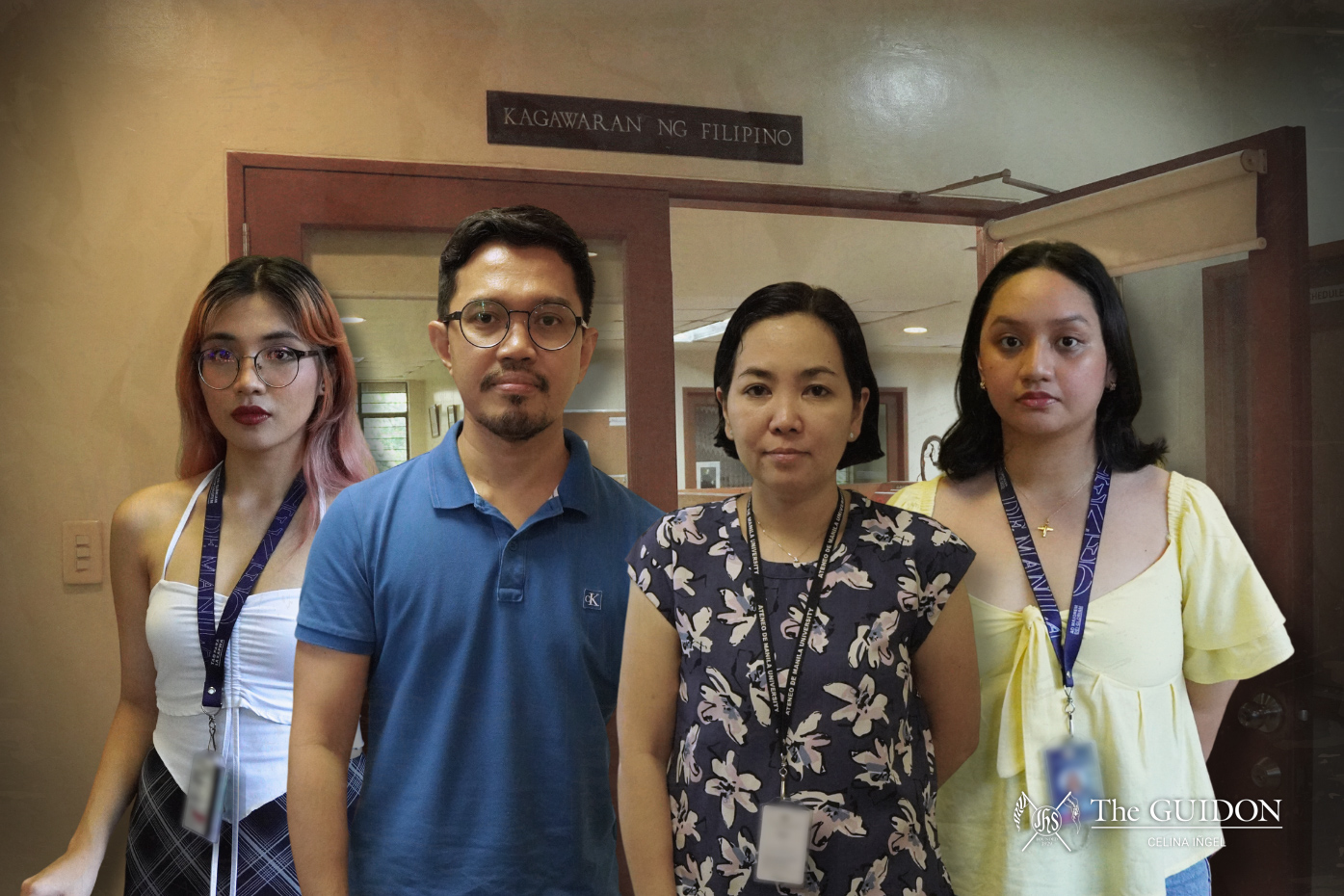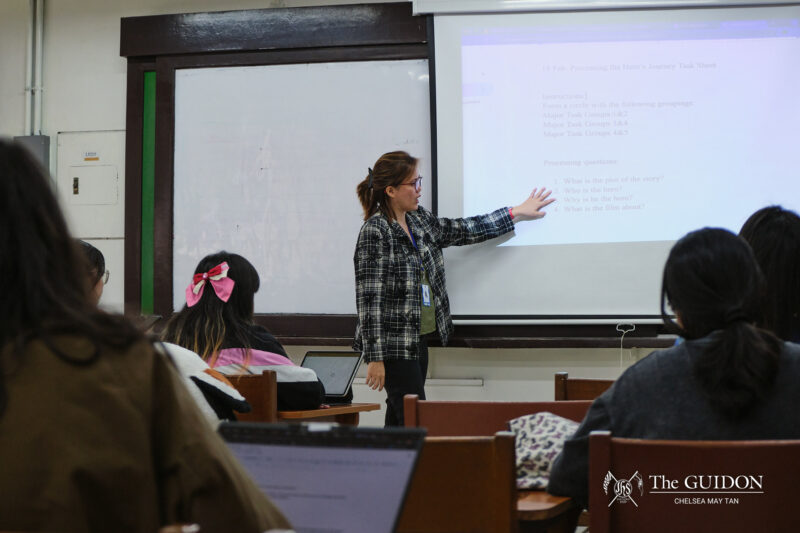FILIPINO IS ironically a subject often sidelined in the Philippines, as evidenced by the use of English as the official medium of instruction and the removal of the country’s native language in different levels of education.
In particular, the Commission on Higher Education (CHED) released Memorandum Order No. 20 Series of 2013, abolishing Filipino as a required core subject in Higher Education. Last year, the mother tongue was also removed as a separate subject upon the launch of the MATATAG K-10 curriculum. More recently, the Senate also approved a bill discontinuing the use of mother tongue as a medium of instruction from Kindergarten to Grade 3.
This devaluation of Filipino in the academe is likewise reflected in the dwindling population of Filipino majors in the Ateneo. Current records of the Filipino Department show that there are only two students taking AB Panitikang Filipino (PanFil) and eight under its equivalent minor program.
While the University still mandates Filipino subjects in its core curriculum, repeated changes in the country’s educational direction call for a need to reexamine the state of Filipino in the University.
Two-pronged dilemma
The Filipino Department offers three undergraduate programs in PanFil: the Bachelor of Arts (AB) degree, an integrated AB and Master of Arts (AB-MA) option, and a Minor in PanFil. While students initially apply into the program, Filipino Department Chair Edgar C. Samar, PhD reveals that only a few decide to proceed with enrollment.
Angelique Glorioso (3 BS BIO) was previously one of the students who eventually enrolled in the program. Despite enjoying her classes under AB PanFil, she shared that external pressure and the “lack” of job opportunities made her switch to her current degree.
Meanwhile, AB PanFil Supersenior Kristine Flores initially had similar intentions to shift, but her plans changed after taking the classes that highlighted the significance of her degree, stating that the Filipino identity hinges on its language.
In her 20 years of teaching, Filipino Assistant Professor Claudette M. Ulit, PhD acknowledges such realities, citing deeply-rooted presumptions as possible causes for low enrollment.
“Siguro dahil na rin sa kolonyal na mentalidad na ‘Panitikang Filipino’ nga ito, at hindi malinaw sa kanila ang trabahong naghihintay sa kanila pagkatapos (It’s likely because of the colonial mentality regarding Filipino literature, and the uncertainty regarding the job opportunities that await them after graduating,)” Ulit explains.
However, she clarifies misconceptions about the course’s lack of careers by highlighting the skills honed under the degree and its use in various fields, such as education, research, and international relations.
Although Filipino courses are mostly offered to AB PanFil students, all Ateneans are required to take FILI 11 and FILI 12 for the University’s core curriculum. In 2018, however, the Ateneo de Manila notably reduced its Filipino core courses from nine to six units in alignment with the CHED memorandum.
Even with the reduced number of units, Flores recalls fellow students questioning the relevance of Filipino core subjects, believing that topics under the required courses have already been covered in basic education.
In response, Samar points out that the Filipino discipline is more than just language or literature, but rather an interdisciplinary field exploring cultural worldviews.
More than a language
For Samar, the depreciation of the Filipino language and discipline stems from systemic issues in the country’s education system, economic demands, and historical context.
The most prominent legacy of colonialism in the country is the English language, which has contemporarily helped Filipinos compete with the globalized job market. However, it has also resulted in the reduced use of native Philippine languages, especially in private schools, where they are used in only a few subjects.
A product of this influence is the conyo student, a stereotype pertaining to those who hail from private schools and speak a mixed form of Tagalog and English called “Taglish.”
Ateneans famously embody this stereotype, especially as many students come from private institutions. Both Samar and Ulit affirm this reality, detailing the students’ frequent use of English in their daily conversations.
Ulit remarks that, while she has had exceptional students, many Ateneans in her FILI 11 and 12 classes struggle with speaking, reading, and writing in Filipino. Flores and Glorioso also notice that their schoolmates are often intimidated by Filipino classes.
With Ateneans’ current disposition toward Filipino, Samar underscores the vitality of intellectualizing the language and expanding its usage. “Hindi nakikitang pangangailangan [ang wikang Filipino] sa ibang fields. […] [K]ung nagpapakahusay tayo sa mga disciplines na pinag-aaralan natin, baka paglabas natin ng Ateneo, hindi tayo makaugnay sa mga kababayan natin,” he explains.
(The Filipino language is not seen as a need in other fields. […] [E]ven if we strive for excellence in the disciplines we study, when we leave the Ateneo, we might find that we cannot connect with our countrymen.)
As such, courses such as Theology and Philosophy are taught in both Filipino and English. For Ulit, using the former asserts the language’s intellectual value in other fields.
A bridge to beyond
The breadth of knowledge offered by Filipino language and literature imbibes in students a genuine appreciation of national culture and identity. Samar believes it enables them to empathize with the realities of those outside the Ateneo.
Even so, the structure of the education system supports the status quo of the majority of Ateneans, thus rendering a foreign tongue the comfort zone. This disconnect between Ateneans and the Filipino language and identity is what the Filipino Department aims to reconcile through its ongoing initiatives.
For instance, the Department offers electives, such as Kulturang Popular at Usapin ng Kasarian (PNTKN 149.03i) and Mga Panitikan at Pelikula ng Siyudad: Panahon ng Batas Militar (PNTKN 135.03i), to target the interests of the student body. They also hold periodic reviews of their offered curricula and have begun reassessing and recalibrating the content of the AB PanFil program.
Outside the classroom, the Department engages in partnerships with student organizations to immerse Ateneans in varying forms of national arts and culture. These partnerships involve Baybayin Ateneo for Buwan ng Wika at Kultura, and Tanghalang Ateneo and Ateneo ENTABLADO for plays that supplement their lessons.
Though the University has the capacity to provide such opportunities, Ulit expressed that the nationwide removal of Filipino subjects in college curricula jeopardizes the value that future generations may give to national language, literature, and culture.
As such, Ulit emphasizes that language cannot be valuable if it is unused. “Tandaan natin na hindi kayang umunlad nang mag-isa ng wika; kailangang magsimula ito sa atin. Kailangan natin itong gamitin,” she imparts.
(Remember that language cannot flourish on its own; it needs to start with us. We need to use it.)
Although the imperative of studying Filipino diametrically opposes the demands of the globalized world, the pursuit of nation-building necessitates that Filipino is taught to students from start to finish, as English remains a dominant form of communication—na pinapakita rin ng artikulong ito na nakasulat sa Ingles (as shown by this article written in English).







